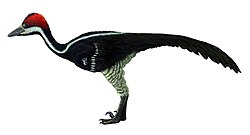Discovery and naming
On 9 September 2004, a lower jaw of a small theropod was uncovered by Anton Sergeevich Rezwiy near Itemir in the IT-01 quarry near Dzharakuduk. [1]
The type species, Urbacodon itemirensis, was named by Alexandr Averianov and Hans-Dieter Sues in 2007. The first part of the generic name Urbacodon is an acronym, honouring the Uzbek, Russian, British, American and Canadian scientists who participated in its discovery. This acronym was combined with a Greek ὀδών, odon, "tooth". The specific name refers to the provenance from Itemir. [1]
The name was based on the holotype ZIN PH 944/16, a single left dentary with preserved replacement teeth from the Cenomanian Dzharakuduk Formation. Averianov and Sues also identified teeth and other material, earlier described by Lev Nessov, as a Urbacodon sp. from the nearby Turonian Bissekty Formation. [1]
In 2024, Wang et al. described a partial right dentary collected from the Iren Dabasu Formation in the late 1990s. Based on similarities with U. itemirensis, they described the specimen as belonging to a new species of Urbacodon, which they named U. norelli. The two specimens share a lightly built and strap-like dentary that is curved inward at the tip, a symphyseal foramen on the dentary, and thickened dentary teeth, among other features. [2]
This page is based on this
Wikipedia article Text is available under the
CC BY-SA 4.0 license; additional terms may apply.
Images, videos and audio are available under their respective licenses.

